Understanding People in Organisations
VerifiedAdded on 2020/12/29
|14
|4587
|414
Homework Assignment
AI Summary
This assignment analyzes the application of scientific management principles, personality testing, job satisfaction, leadership approaches, and conflict resolution in a retail setting, using the example of Superbrand.
Contribute Materials
Your contribution can guide someone’s learning journey. Share your
documents today.
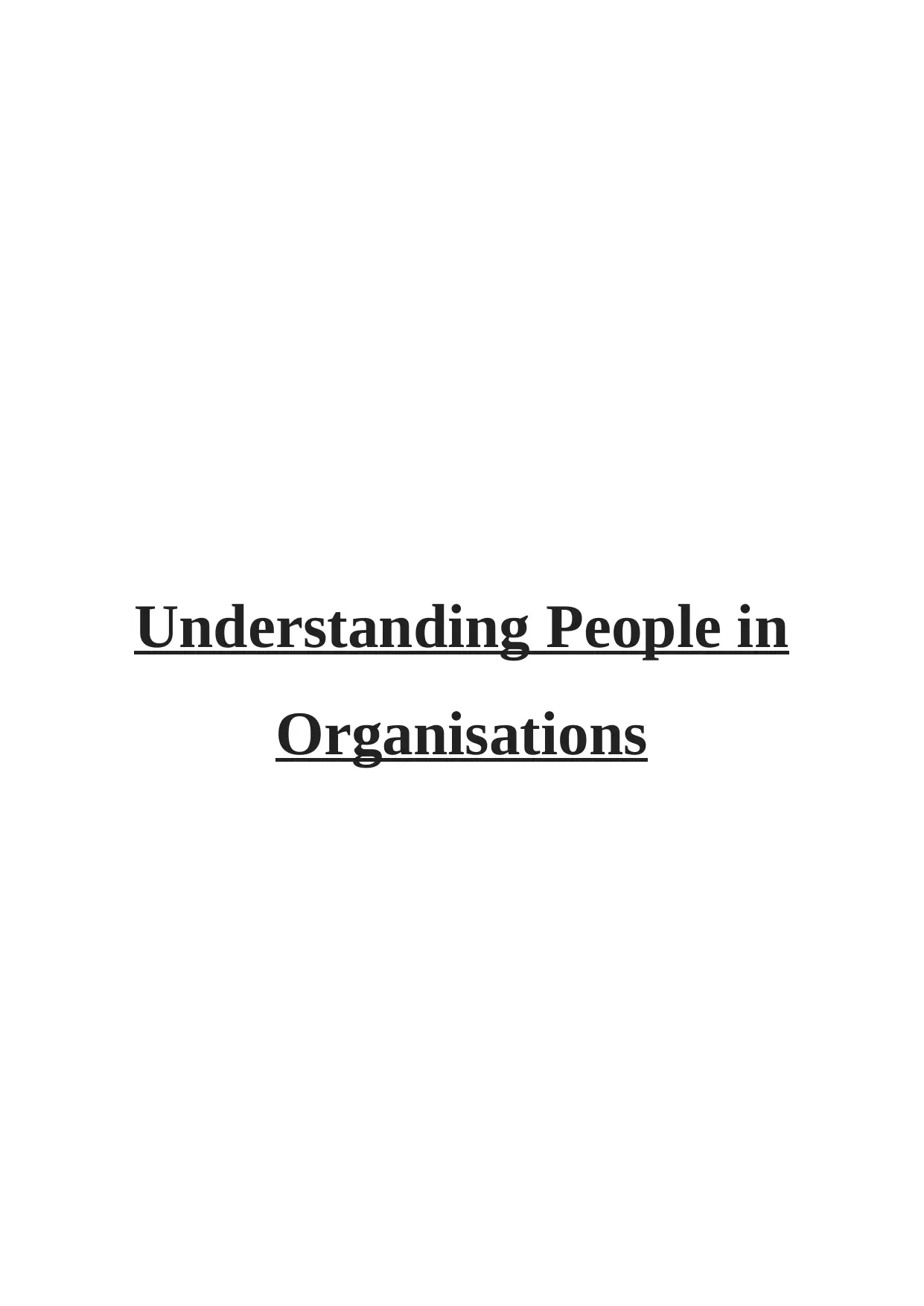
Understanding People in
Organisations
Organisations
Secure Best Marks with AI Grader
Need help grading? Try our AI Grader for instant feedback on your assignments.
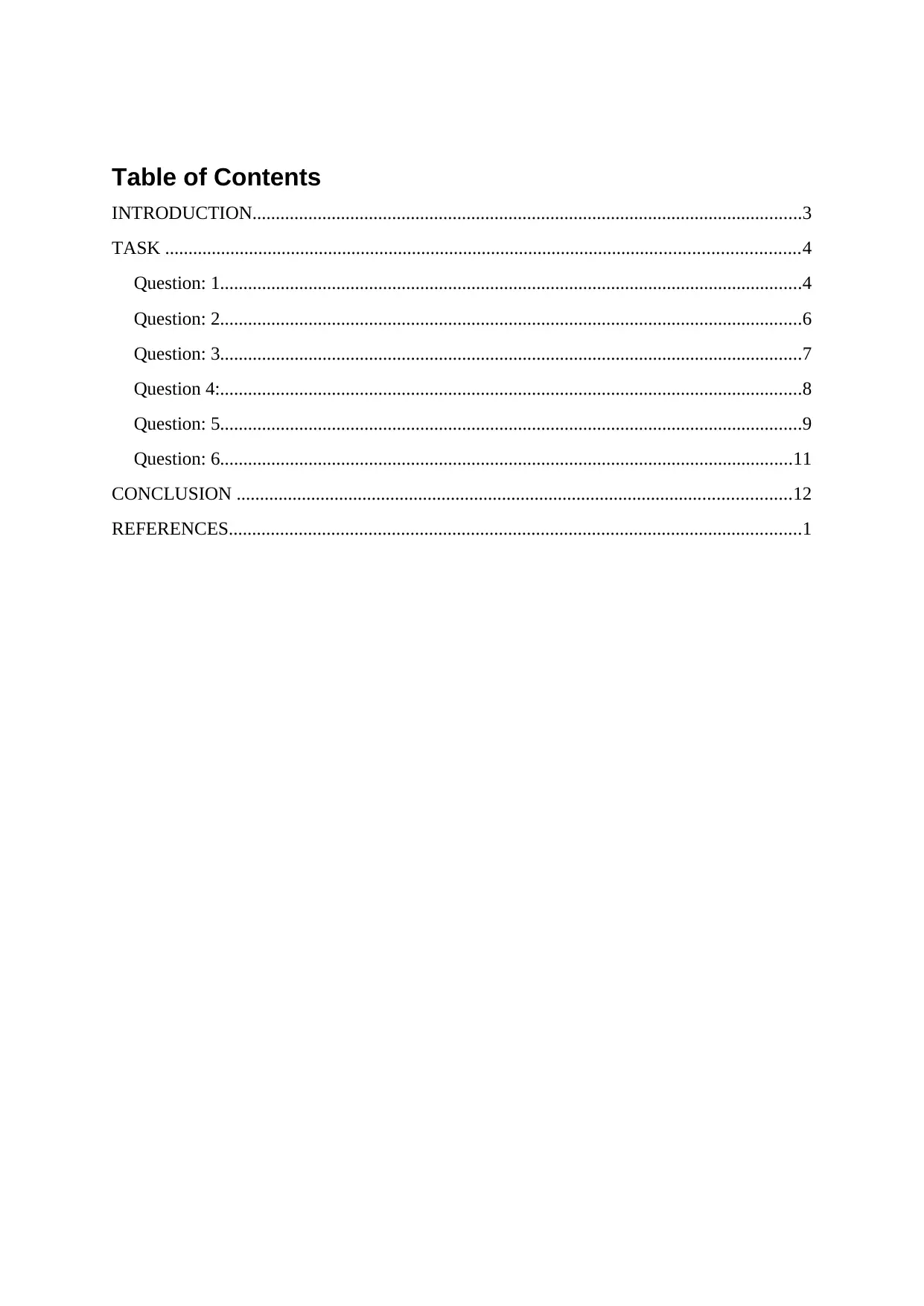
Table of Contents
INTRODUCTION......................................................................................................................3
TASK ........................................................................................................................................4
Question: 1.............................................................................................................................4
Question: 2.............................................................................................................................6
Question: 3.............................................................................................................................7
Question 4:.............................................................................................................................8
Question: 5.............................................................................................................................9
Question: 6...........................................................................................................................11
CONCLUSION .......................................................................................................................12
REFERENCES...........................................................................................................................1
INTRODUCTION......................................................................................................................3
TASK ........................................................................................................................................4
Question: 1.............................................................................................................................4
Question: 2.............................................................................................................................6
Question: 3.............................................................................................................................7
Question 4:.............................................................................................................................8
Question: 5.............................................................................................................................9
Question: 6...........................................................................................................................11
CONCLUSION .......................................................................................................................12
REFERENCES...........................................................................................................................1
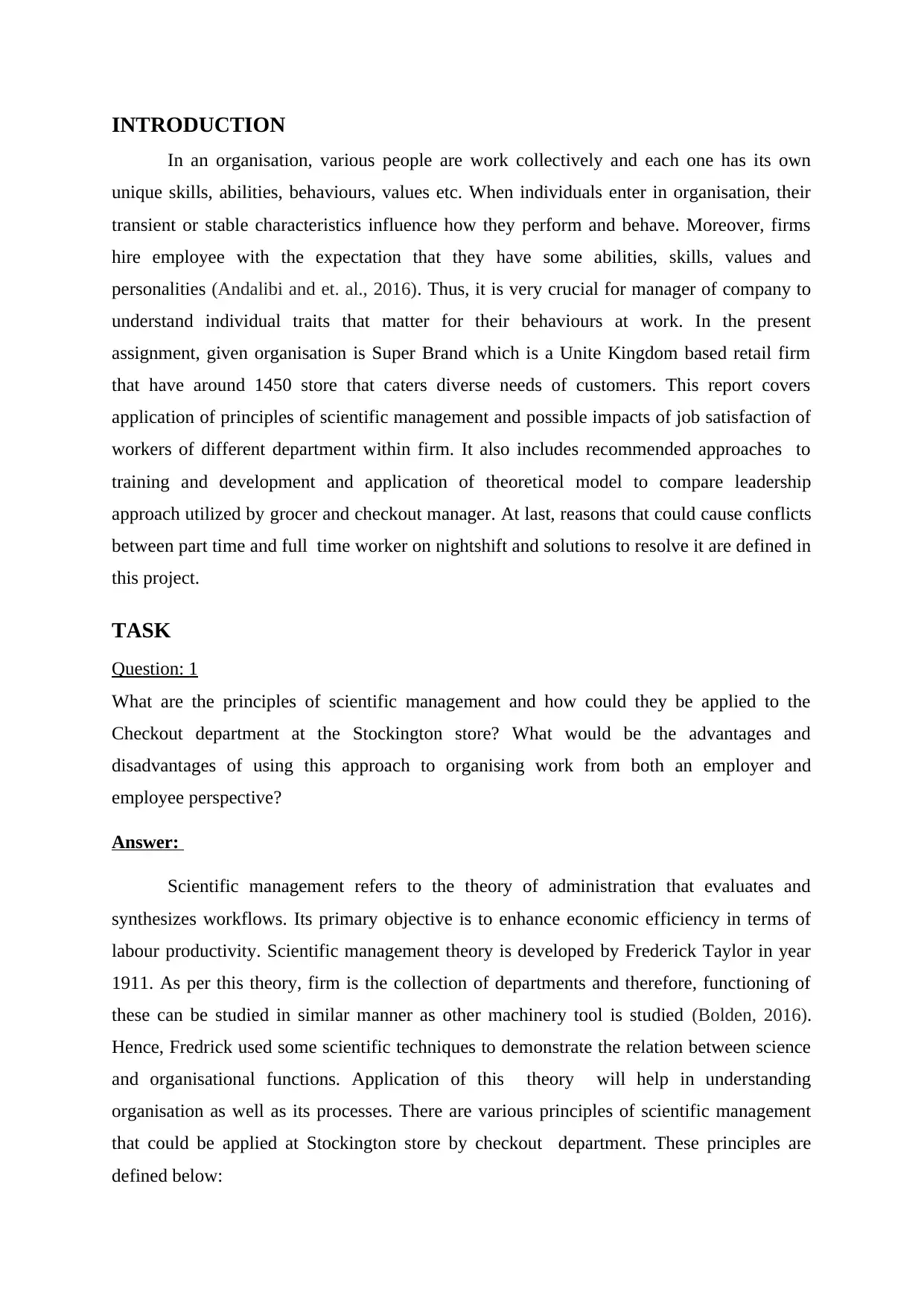
INTRODUCTION
In an organisation, various people are work collectively and each one has its own
unique skills, abilities, behaviours, values etc. When individuals enter in organisation, their
transient or stable characteristics influence how they perform and behave. Moreover, firms
hire employee with the expectation that they have some abilities, skills, values and
personalities (Andalibi and et. al., 2016). Thus, it is very crucial for manager of company to
understand individual traits that matter for their behaviours at work. In the present
assignment, given organisation is Super Brand which is a Unite Kingdom based retail firm
that have around 1450 store that caters diverse needs of customers. This report covers
application of principles of scientific management and possible impacts of job satisfaction of
workers of different department within firm. It also includes recommended approaches to
training and development and application of theoretical model to compare leadership
approach utilized by grocer and checkout manager. At last, reasons that could cause conflicts
between part time and full time worker on nightshift and solutions to resolve it are defined in
this project.
TASK
Question: 1
What are the principles of scientific management and how could they be applied to the
Checkout department at the Stockington store? What would be the advantages and
disadvantages of using this approach to organising work from both an employer and
employee perspective?
Answer:
Scientific management refers to the theory of administration that evaluates and
synthesizes workflows. Its primary objective is to enhance economic efficiency in terms of
labour productivity. Scientific management theory is developed by Frederick Taylor in year
1911. As per this theory, firm is the collection of departments and therefore, functioning of
these can be studied in similar manner as other machinery tool is studied (Bolden, 2016).
Hence, Fredrick used some scientific techniques to demonstrate the relation between science
and organisational functions. Application of this theory will help in understanding
organisation as well as its processes. There are various principles of scientific management
that could be applied at Stockington store by checkout department. These principles are
defined below:
In an organisation, various people are work collectively and each one has its own
unique skills, abilities, behaviours, values etc. When individuals enter in organisation, their
transient or stable characteristics influence how they perform and behave. Moreover, firms
hire employee with the expectation that they have some abilities, skills, values and
personalities (Andalibi and et. al., 2016). Thus, it is very crucial for manager of company to
understand individual traits that matter for their behaviours at work. In the present
assignment, given organisation is Super Brand which is a Unite Kingdom based retail firm
that have around 1450 store that caters diverse needs of customers. This report covers
application of principles of scientific management and possible impacts of job satisfaction of
workers of different department within firm. It also includes recommended approaches to
training and development and application of theoretical model to compare leadership
approach utilized by grocer and checkout manager. At last, reasons that could cause conflicts
between part time and full time worker on nightshift and solutions to resolve it are defined in
this project.
TASK
Question: 1
What are the principles of scientific management and how could they be applied to the
Checkout department at the Stockington store? What would be the advantages and
disadvantages of using this approach to organising work from both an employer and
employee perspective?
Answer:
Scientific management refers to the theory of administration that evaluates and
synthesizes workflows. Its primary objective is to enhance economic efficiency in terms of
labour productivity. Scientific management theory is developed by Frederick Taylor in year
1911. As per this theory, firm is the collection of departments and therefore, functioning of
these can be studied in similar manner as other machinery tool is studied (Bolden, 2016).
Hence, Fredrick used some scientific techniques to demonstrate the relation between science
and organisational functions. Application of this theory will help in understanding
organisation as well as its processes. There are various principles of scientific management
that could be applied at Stockington store by checkout department. These principles are
defined below:
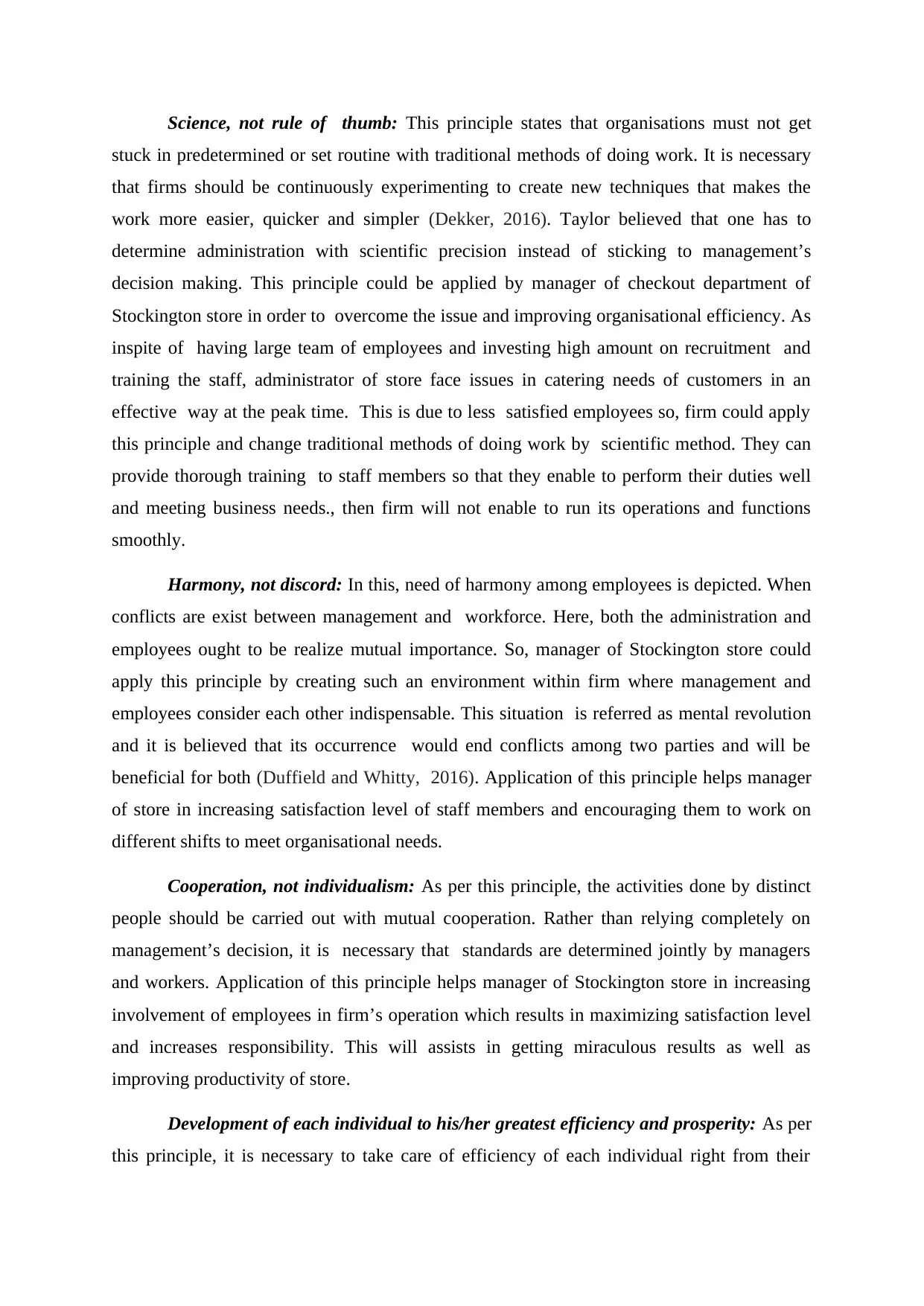
Science, not rule of thumb: This principle states that organisations must not get
stuck in predetermined or set routine with traditional methods of doing work. It is necessary
that firms should be continuously experimenting to create new techniques that makes the
work more easier, quicker and simpler (Dekker, 2016). Taylor believed that one has to
determine administration with scientific precision instead of sticking to management’s
decision making. This principle could be applied by manager of checkout department of
Stockington store in order to overcome the issue and improving organisational efficiency. As
inspite of having large team of employees and investing high amount on recruitment and
training the staff, administrator of store face issues in catering needs of customers in an
effective way at the peak time. This is due to less satisfied employees so, firm could apply
this principle and change traditional methods of doing work by scientific method. They can
provide thorough training to staff members so that they enable to perform their duties well
and meeting business needs., then firm will not enable to run its operations and functions
smoothly.
Harmony, not discord: In this, need of harmony among employees is depicted. When
conflicts are exist between management and workforce. Here, both the administration and
employees ought to be realize mutual importance. So, manager of Stockington store could
apply this principle by creating such an environment within firm where management and
employees consider each other indispensable. This situation is referred as mental revolution
and it is believed that its occurrence would end conflicts among two parties and will be
beneficial for both (Duffield and Whitty, 2016). Application of this principle helps manager
of store in increasing satisfaction level of staff members and encouraging them to work on
different shifts to meet organisational needs.
Cooperation, not individualism: As per this principle, the activities done by distinct
people should be carried out with mutual cooperation. Rather than relying completely on
management’s decision, it is necessary that standards are determined jointly by managers
and workers. Application of this principle helps manager of Stockington store in increasing
involvement of employees in firm’s operation which results in maximizing satisfaction level
and increases responsibility. This will assists in getting miraculous results as well as
improving productivity of store.
Development of each individual to his/her greatest efficiency and prosperity: As per
this principle, it is necessary to take care of efficiency of each individual right from their
stuck in predetermined or set routine with traditional methods of doing work. It is necessary
that firms should be continuously experimenting to create new techniques that makes the
work more easier, quicker and simpler (Dekker, 2016). Taylor believed that one has to
determine administration with scientific precision instead of sticking to management’s
decision making. This principle could be applied by manager of checkout department of
Stockington store in order to overcome the issue and improving organisational efficiency. As
inspite of having large team of employees and investing high amount on recruitment and
training the staff, administrator of store face issues in catering needs of customers in an
effective way at the peak time. This is due to less satisfied employees so, firm could apply
this principle and change traditional methods of doing work by scientific method. They can
provide thorough training to staff members so that they enable to perform their duties well
and meeting business needs., then firm will not enable to run its operations and functions
smoothly.
Harmony, not discord: In this, need of harmony among employees is depicted. When
conflicts are exist between management and workforce. Here, both the administration and
employees ought to be realize mutual importance. So, manager of Stockington store could
apply this principle by creating such an environment within firm where management and
employees consider each other indispensable. This situation is referred as mental revolution
and it is believed that its occurrence would end conflicts among two parties and will be
beneficial for both (Duffield and Whitty, 2016). Application of this principle helps manager
of store in increasing satisfaction level of staff members and encouraging them to work on
different shifts to meet organisational needs.
Cooperation, not individualism: As per this principle, the activities done by distinct
people should be carried out with mutual cooperation. Rather than relying completely on
management’s decision, it is necessary that standards are determined jointly by managers
and workers. Application of this principle helps manager of Stockington store in increasing
involvement of employees in firm’s operation which results in maximizing satisfaction level
and increases responsibility. This will assists in getting miraculous results as well as
improving productivity of store.
Development of each individual to his/her greatest efficiency and prosperity: As per
this principle, it is necessary to take care of efficiency of each individual right from their
Secure Best Marks with AI Grader
Need help grading? Try our AI Grader for instant feedback on your assignments.
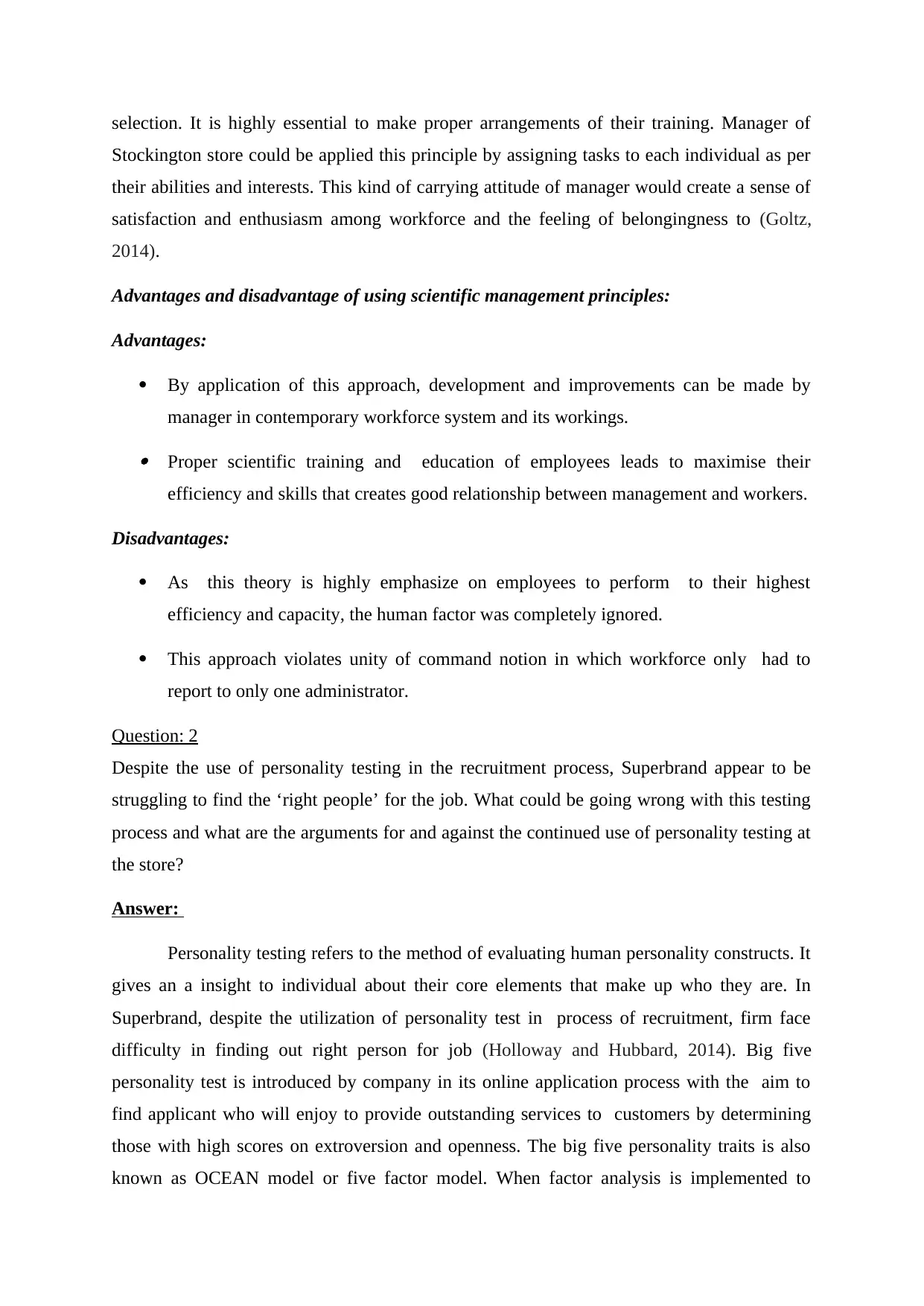
selection. It is highly essential to make proper arrangements of their training. Manager of
Stockington store could be applied this principle by assigning tasks to each individual as per
their abilities and interests. This kind of carrying attitude of manager would create a sense of
satisfaction and enthusiasm among workforce and the feeling of belongingness to (Goltz,
2014).
Advantages and disadvantage of using scientific management principles:
Advantages:
By application of this approach, development and improvements can be made by
manager in contemporary workforce system and its workings. Proper scientific training and education of employees leads to maximise their
efficiency and skills that creates good relationship between management and workers.
Disadvantages:
As this theory is highly emphasize on employees to perform to their highest
efficiency and capacity, the human factor was completely ignored.
This approach violates unity of command notion in which workforce only had to
report to only one administrator.
Question: 2
Despite the use of personality testing in the recruitment process, Superbrand appear to be
struggling to find the ‘right people’ for the job. What could be going wrong with this testing
process and what are the arguments for and against the continued use of personality testing at
the store?
Answer:
Personality testing refers to the method of evaluating human personality constructs. It
gives an a insight to individual about their core elements that make up who they are. In
Superbrand, despite the utilization of personality test in process of recruitment, firm face
difficulty in finding out right person for job (Holloway and Hubbard, 2014). Big five
personality test is introduced by company in its online application process with the aim to
find applicant who will enjoy to provide outstanding services to customers by determining
those with high scores on extroversion and openness. The big five personality traits is also
known as OCEAN model or five factor model. When factor analysis is implemented to
Stockington store could be applied this principle by assigning tasks to each individual as per
their abilities and interests. This kind of carrying attitude of manager would create a sense of
satisfaction and enthusiasm among workforce and the feeling of belongingness to (Goltz,
2014).
Advantages and disadvantage of using scientific management principles:
Advantages:
By application of this approach, development and improvements can be made by
manager in contemporary workforce system and its workings. Proper scientific training and education of employees leads to maximise their
efficiency and skills that creates good relationship between management and workers.
Disadvantages:
As this theory is highly emphasize on employees to perform to their highest
efficiency and capacity, the human factor was completely ignored.
This approach violates unity of command notion in which workforce only had to
report to only one administrator.
Question: 2
Despite the use of personality testing in the recruitment process, Superbrand appear to be
struggling to find the ‘right people’ for the job. What could be going wrong with this testing
process and what are the arguments for and against the continued use of personality testing at
the store?
Answer:
Personality testing refers to the method of evaluating human personality constructs. It
gives an a insight to individual about their core elements that make up who they are. In
Superbrand, despite the utilization of personality test in process of recruitment, firm face
difficulty in finding out right person for job (Holloway and Hubbard, 2014). Big five
personality test is introduced by company in its online application process with the aim to
find applicant who will enjoy to provide outstanding services to customers by determining
those with high scores on extroversion and openness. The big five personality traits is also
known as OCEAN model or five factor model. When factor analysis is implemented to
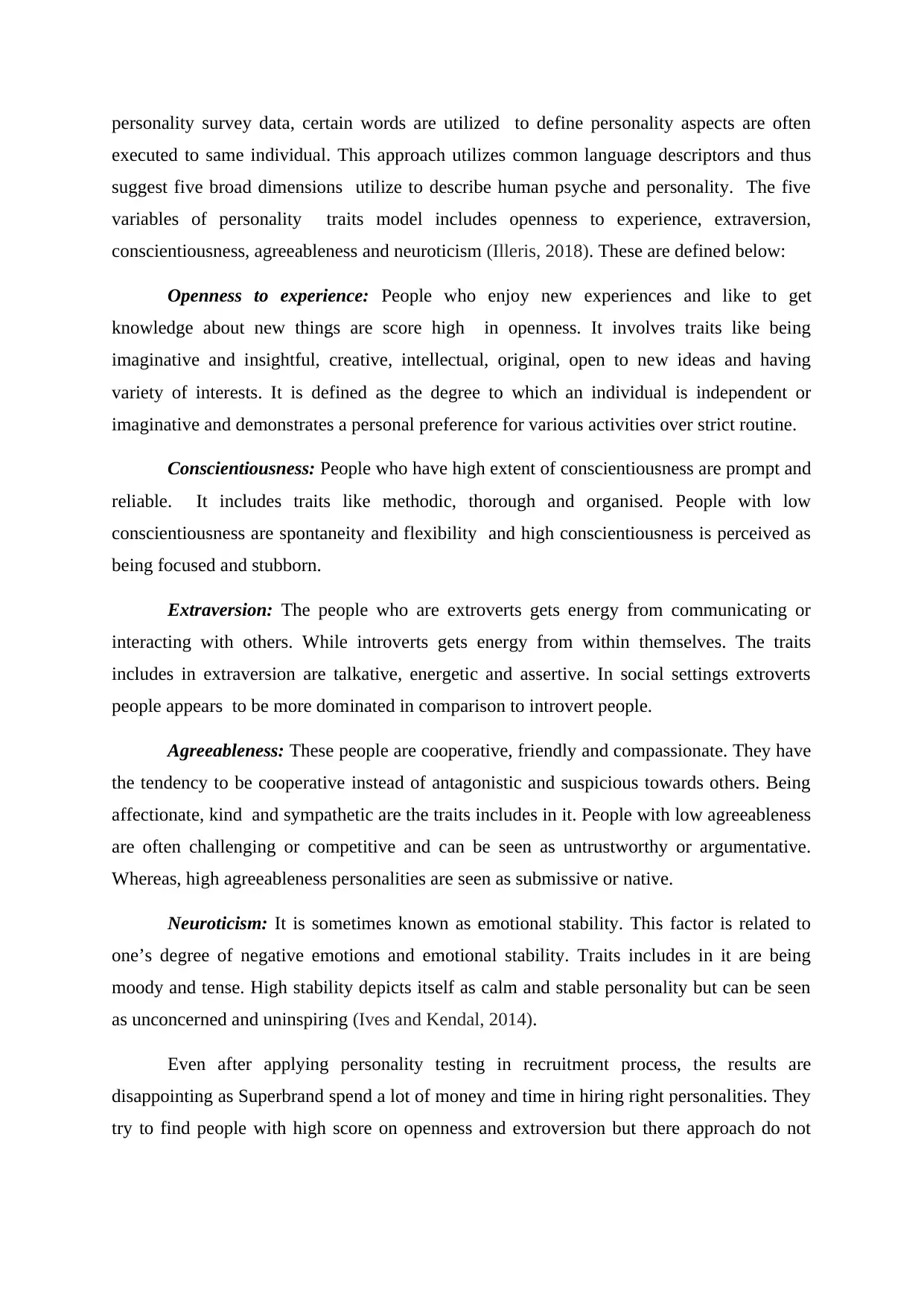
personality survey data, certain words are utilized to define personality aspects are often
executed to same individual. This approach utilizes common language descriptors and thus
suggest five broad dimensions utilize to describe human psyche and personality. The five
variables of personality traits model includes openness to experience, extraversion,
conscientiousness, agreeableness and neuroticism (Illeris, 2018). These are defined below:
Openness to experience: People who enjoy new experiences and like to get
knowledge about new things are score high in openness. It involves traits like being
imaginative and insightful, creative, intellectual, original, open to new ideas and having
variety of interests. It is defined as the degree to which an individual is independent or
imaginative and demonstrates a personal preference for various activities over strict routine.
Conscientiousness: People who have high extent of conscientiousness are prompt and
reliable. It includes traits like methodic, thorough and organised. People with low
conscientiousness are spontaneity and flexibility and high conscientiousness is perceived as
being focused and stubborn.
Extraversion: The people who are extroverts gets energy from communicating or
interacting with others. While introverts gets energy from within themselves. The traits
includes in extraversion are talkative, energetic and assertive. In social settings extroverts
people appears to be more dominated in comparison to introvert people.
Agreeableness: These people are cooperative, friendly and compassionate. They have
the tendency to be cooperative instead of antagonistic and suspicious towards others. Being
affectionate, kind and sympathetic are the traits includes in it. People with low agreeableness
are often challenging or competitive and can be seen as untrustworthy or argumentative.
Whereas, high agreeableness personalities are seen as submissive or native.
Neuroticism: It is sometimes known as emotional stability. This factor is related to
one’s degree of negative emotions and emotional stability. Traits includes in it are being
moody and tense. High stability depicts itself as calm and stable personality but can be seen
as unconcerned and uninspiring (Ives and Kendal, 2014).
Even after applying personality testing in recruitment process, the results are
disappointing as Superbrand spend a lot of money and time in hiring right personalities. They
try to find people with high score on openness and extroversion but there approach do not
executed to same individual. This approach utilizes common language descriptors and thus
suggest five broad dimensions utilize to describe human psyche and personality. The five
variables of personality traits model includes openness to experience, extraversion,
conscientiousness, agreeableness and neuroticism (Illeris, 2018). These are defined below:
Openness to experience: People who enjoy new experiences and like to get
knowledge about new things are score high in openness. It involves traits like being
imaginative and insightful, creative, intellectual, original, open to new ideas and having
variety of interests. It is defined as the degree to which an individual is independent or
imaginative and demonstrates a personal preference for various activities over strict routine.
Conscientiousness: People who have high extent of conscientiousness are prompt and
reliable. It includes traits like methodic, thorough and organised. People with low
conscientiousness are spontaneity and flexibility and high conscientiousness is perceived as
being focused and stubborn.
Extraversion: The people who are extroverts gets energy from communicating or
interacting with others. While introverts gets energy from within themselves. The traits
includes in extraversion are talkative, energetic and assertive. In social settings extroverts
people appears to be more dominated in comparison to introvert people.
Agreeableness: These people are cooperative, friendly and compassionate. They have
the tendency to be cooperative instead of antagonistic and suspicious towards others. Being
affectionate, kind and sympathetic are the traits includes in it. People with low agreeableness
are often challenging or competitive and can be seen as untrustworthy or argumentative.
Whereas, high agreeableness personalities are seen as submissive or native.
Neuroticism: It is sometimes known as emotional stability. This factor is related to
one’s degree of negative emotions and emotional stability. Traits includes in it are being
moody and tense. High stability depicts itself as calm and stable personality but can be seen
as unconcerned and uninspiring (Ives and Kendal, 2014).
Even after applying personality testing in recruitment process, the results are
disappointing as Superbrand spend a lot of money and time in hiring right personalities. They
try to find people with high score on openness and extroversion but there approach do not

seems to be working which could be the main reason behind failure in hiring right people that
fit the job description.
Question: 3
Compare the characteristics of the jobs carried out by the Grocery team and the Nightshift
workers and discuss the possible impact of this on the job satisfaction of workers in the two
departments. What could the Nightshift manager do to improve the work attitudes of workers
on his team?
Answer:
Both the grocery team and nightshift workers carry out different jobs that may impact
on their level of job satisfaction. The grocery department of Stockington store covers five
areas including bakery, dried goods, frozen food, fruits and vegetables and chilled foods. The
main job of grocery team is to interact with customers (Larsson, 2017). They resolve
client’s issues, initiates returns, verify their accounts and greet them warmly. Some other
duties of grocery team includes bagging groceries, reconciling receipts with cash, scanning
items within store etc. Grocery team also assist customer in finding out the foods they need.
The main duties of nightshift workers includes replenishing the shelves from late
night delivery. They read inventory reports or visually inspects retail areas to identify what
to add and unpack boxes from warehouses and storerooms. If they found damaged
merchandise, then it is their responsibility to inform managers and supervisors and a set them
aside for replacement or repair. For maintaining up to date or accurate record, nightshift
workers record their activities. If they found low inventory, they inform to inventory control
staff for reordering the items.
The potential impacts of job carried out by grocery team and night shift workers on
their job satisfaction is that shift workers are suffering from stress which is arise by
consistent night shifts. If the employees are temporary workers then it is appeared that the job
satisfaction level of permanent regular worker is low as mental and physical issues are likely
to be exacerbated. Apart from this, job involvement, fair promotion can also significantly
impact on job satisfaction (Lewis, 2016). This will also impacts on relation of workforce and
supervisor. The employees are more impacted by pleasant work environment and
employment status. In case of grocery team, if employees are not rewarded by management
for their work, then it may impact on their performance and job satisfaction level. They can
fit the job description.
Question: 3
Compare the characteristics of the jobs carried out by the Grocery team and the Nightshift
workers and discuss the possible impact of this on the job satisfaction of workers in the two
departments. What could the Nightshift manager do to improve the work attitudes of workers
on his team?
Answer:
Both the grocery team and nightshift workers carry out different jobs that may impact
on their level of job satisfaction. The grocery department of Stockington store covers five
areas including bakery, dried goods, frozen food, fruits and vegetables and chilled foods. The
main job of grocery team is to interact with customers (Larsson, 2017). They resolve
client’s issues, initiates returns, verify their accounts and greet them warmly. Some other
duties of grocery team includes bagging groceries, reconciling receipts with cash, scanning
items within store etc. Grocery team also assist customer in finding out the foods they need.
The main duties of nightshift workers includes replenishing the shelves from late
night delivery. They read inventory reports or visually inspects retail areas to identify what
to add and unpack boxes from warehouses and storerooms. If they found damaged
merchandise, then it is their responsibility to inform managers and supervisors and a set them
aside for replacement or repair. For maintaining up to date or accurate record, nightshift
workers record their activities. If they found low inventory, they inform to inventory control
staff for reordering the items.
The potential impacts of job carried out by grocery team and night shift workers on
their job satisfaction is that shift workers are suffering from stress which is arise by
consistent night shifts. If the employees are temporary workers then it is appeared that the job
satisfaction level of permanent regular worker is low as mental and physical issues are likely
to be exacerbated. Apart from this, job involvement, fair promotion can also significantly
impact on job satisfaction (Lewis, 2016). This will also impacts on relation of workforce and
supervisor. The employees are more impacted by pleasant work environment and
employment status. In case of grocery team, if employees are not rewarded by management
for their work, then it may impact on their performance and job satisfaction level. They can
Paraphrase This Document
Need a fresh take? Get an instant paraphrase of this document with our AI Paraphraser
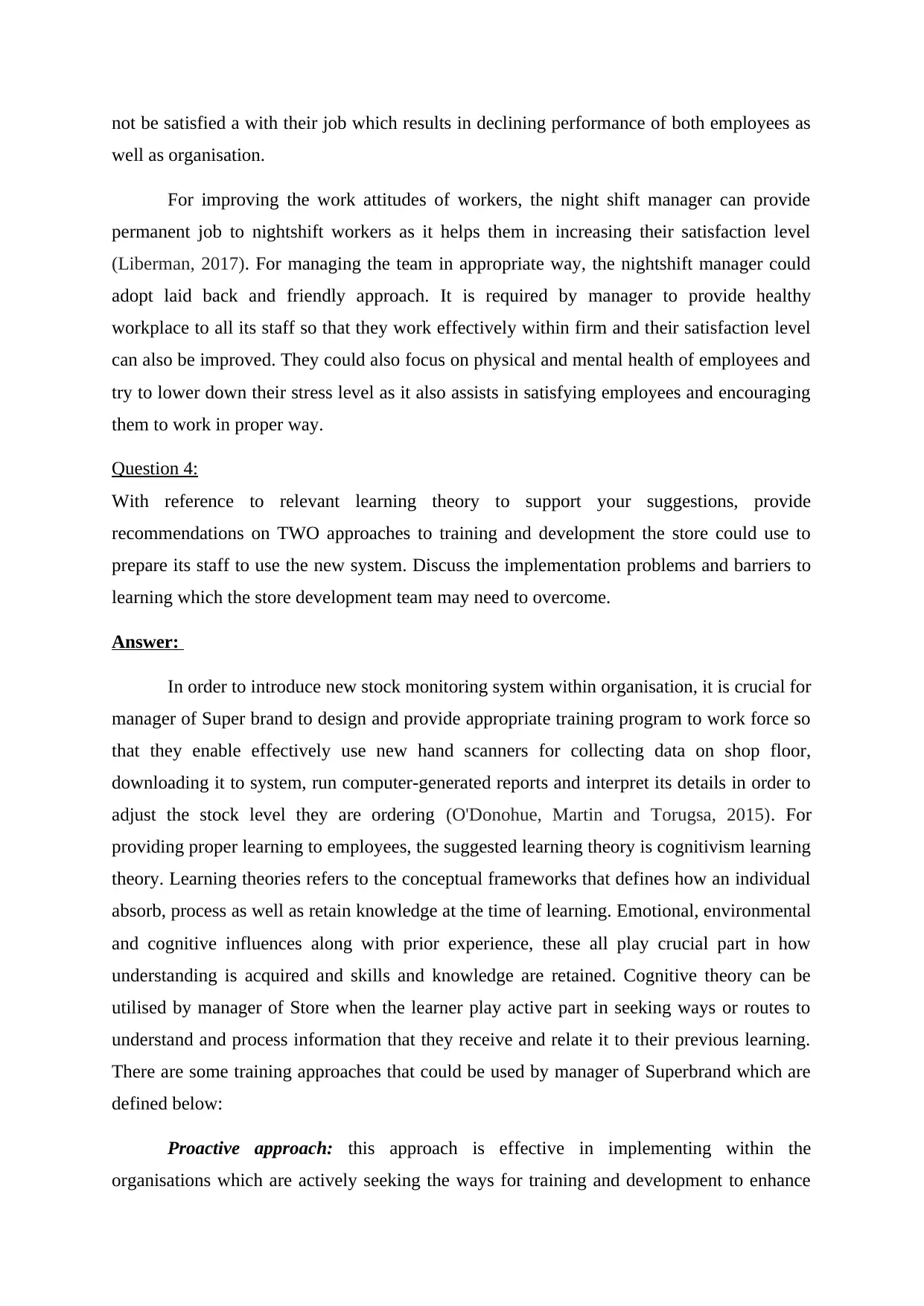
not be satisfied a with their job which results in declining performance of both employees as
well as organisation.
For improving the work attitudes of workers, the night shift manager can provide
permanent job to nightshift workers as it helps them in increasing their satisfaction level
(Liberman, 2017). For managing the team in appropriate way, the nightshift manager could
adopt laid back and friendly approach. It is required by manager to provide healthy
workplace to all its staff so that they work effectively within firm and their satisfaction level
can also be improved. They could also focus on physical and mental health of employees and
try to lower down their stress level as it also assists in satisfying employees and encouraging
them to work in proper way.
Question 4:
With reference to relevant learning theory to support your suggestions, provide
recommendations on TWO approaches to training and development the store could use to
prepare its staff to use the new system. Discuss the implementation problems and barriers to
learning which the store development team may need to overcome.
Answer:
In order to introduce new stock monitoring system within organisation, it is crucial for
manager of Super brand to design and provide appropriate training program to work force so
that they enable effectively use new hand scanners for collecting data on shop floor,
downloading it to system, run computer-generated reports and interpret its details in order to
adjust the stock level they are ordering (O'Donohue, Martin and Torugsa, 2015). For
providing proper learning to employees, the suggested learning theory is cognitivism learning
theory. Learning theories refers to the conceptual frameworks that defines how an individual
absorb, process as well as retain knowledge at the time of learning. Emotional, environmental
and cognitive influences along with prior experience, these all play crucial part in how
understanding is acquired and skills and knowledge are retained. Cognitive theory can be
utilised by manager of Store when the learner play active part in seeking ways or routes to
understand and process information that they receive and relate it to their previous learning.
There are some training approaches that could be used by manager of Superbrand which are
defined below:
Proactive approach: this approach is effective in implementing within the
organisations which are actively seeking the ways for training and development to enhance
well as organisation.
For improving the work attitudes of workers, the night shift manager can provide
permanent job to nightshift workers as it helps them in increasing their satisfaction level
(Liberman, 2017). For managing the team in appropriate way, the nightshift manager could
adopt laid back and friendly approach. It is required by manager to provide healthy
workplace to all its staff so that they work effectively within firm and their satisfaction level
can also be improved. They could also focus on physical and mental health of employees and
try to lower down their stress level as it also assists in satisfying employees and encouraging
them to work in proper way.
Question 4:
With reference to relevant learning theory to support your suggestions, provide
recommendations on TWO approaches to training and development the store could use to
prepare its staff to use the new system. Discuss the implementation problems and barriers to
learning which the store development team may need to overcome.
Answer:
In order to introduce new stock monitoring system within organisation, it is crucial for
manager of Super brand to design and provide appropriate training program to work force so
that they enable effectively use new hand scanners for collecting data on shop floor,
downloading it to system, run computer-generated reports and interpret its details in order to
adjust the stock level they are ordering (O'Donohue, Martin and Torugsa, 2015). For
providing proper learning to employees, the suggested learning theory is cognitivism learning
theory. Learning theories refers to the conceptual frameworks that defines how an individual
absorb, process as well as retain knowledge at the time of learning. Emotional, environmental
and cognitive influences along with prior experience, these all play crucial part in how
understanding is acquired and skills and knowledge are retained. Cognitive theory can be
utilised by manager of Store when the learner play active part in seeking ways or routes to
understand and process information that they receive and relate it to their previous learning.
There are some training approaches that could be used by manager of Superbrand which are
defined below:
Proactive approach: this approach is effective in implementing within the
organisations which are actively seeking the ways for training and development to enhance
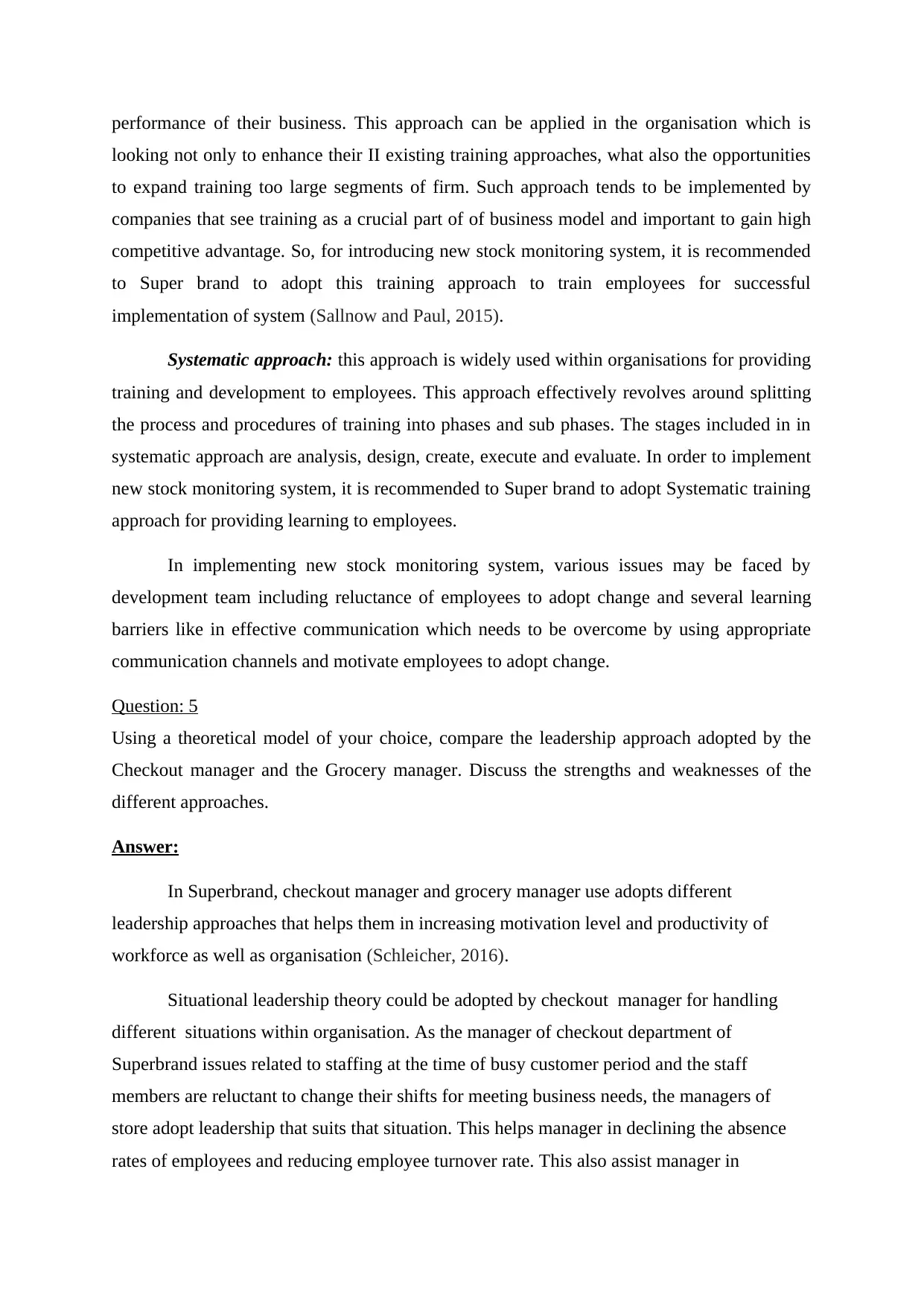
performance of their business. This approach can be applied in the organisation which is
looking not only to enhance their II existing training approaches, what also the opportunities
to expand training too large segments of firm. Such approach tends to be implemented by
companies that see training as a crucial part of of business model and important to gain high
competitive advantage. So, for introducing new stock monitoring system, it is recommended
to Super brand to adopt this training approach to train employees for successful
implementation of system (Sallnow and Paul, 2015).
Systematic approach: this approach is widely used within organisations for providing
training and development to employees. This approach effectively revolves around splitting
the process and procedures of training into phases and sub phases. The stages included in in
systematic approach are analysis, design, create, execute and evaluate. In order to implement
new stock monitoring system, it is recommended to Super brand to adopt Systematic training
approach for providing learning to employees.
In implementing new stock monitoring system, various issues may be faced by
development team including reluctance of employees to adopt change and several learning
barriers like in effective communication which needs to be overcome by using appropriate
communication channels and motivate employees to adopt change.
Question: 5
Using a theoretical model of your choice, compare the leadership approach adopted by the
Checkout manager and the Grocery manager. Discuss the strengths and weaknesses of the
different approaches.
Answer:
In Superbrand, checkout manager and grocery manager use adopts different
leadership approaches that helps them in increasing motivation level and productivity of
workforce as well as organisation (Schleicher, 2016).
Situational leadership theory could be adopted by checkout manager for handling
different situations within organisation. As the manager of checkout department of
Superbrand issues related to staffing at the time of busy customer period and the staff
members are reluctant to change their shifts for meeting business needs, the managers of
store adopt leadership that suits that situation. This helps manager in declining the absence
rates of employees and reducing employee turnover rate. This also assist manager in
looking not only to enhance their II existing training approaches, what also the opportunities
to expand training too large segments of firm. Such approach tends to be implemented by
companies that see training as a crucial part of of business model and important to gain high
competitive advantage. So, for introducing new stock monitoring system, it is recommended
to Super brand to adopt this training approach to train employees for successful
implementation of system (Sallnow and Paul, 2015).
Systematic approach: this approach is widely used within organisations for providing
training and development to employees. This approach effectively revolves around splitting
the process and procedures of training into phases and sub phases. The stages included in in
systematic approach are analysis, design, create, execute and evaluate. In order to implement
new stock monitoring system, it is recommended to Super brand to adopt Systematic training
approach for providing learning to employees.
In implementing new stock monitoring system, various issues may be faced by
development team including reluctance of employees to adopt change and several learning
barriers like in effective communication which needs to be overcome by using appropriate
communication channels and motivate employees to adopt change.
Question: 5
Using a theoretical model of your choice, compare the leadership approach adopted by the
Checkout manager and the Grocery manager. Discuss the strengths and weaknesses of the
different approaches.
Answer:
In Superbrand, checkout manager and grocery manager use adopts different
leadership approaches that helps them in increasing motivation level and productivity of
workforce as well as organisation (Schleicher, 2016).
Situational leadership theory could be adopted by checkout manager for handling
different situations within organisation. As the manager of checkout department of
Superbrand issues related to staffing at the time of busy customer period and the staff
members are reluctant to change their shifts for meeting business needs, the managers of
store adopt leadership that suits that situation. This helps manager in declining the absence
rates of employees and reducing employee turnover rate. This also assist manager in

improving satisfaction level of workforce which enables them to perform their duties well.
All this helps manager of store in improving productivity of workforce as well as
organisation.
Strengths:
This is a practical theory that is intuitively sensible, easy to understand and can be
applied easily in distinct context. This theory put emphasize on flexibility of leader to ensure that their style meets the
needs of subordinates (Sheard, 2014).
Weaknesses:
This approach fails to address how it deals effectively with certain demographic
characteristics.
The model of employees development is ambiguously conceptualize and it is unclear
that how it combine with competence to form four different development levels.
Trait approach could be adopted by grocery manager as it looks for series of mental,
physical or personality traits which are possess by effective leaders only. It is one of the
major leadership approach that are used by organisations in wider context. Some traits of
effective leader includes intelligence, dominance, self- confidence, motivation, cognitive
ability etc. This theory states that there are some set of personality traits that distinguish
leaders from its followers (Shove, Walker and Brown, 2014). This approach emphasizing on
determining various personality characteristics and traits which are related to successful
leadership in various situations. As the Grocery manager of Super brand face some issues in
staffing the department fully. The department is having the issues with amount of outdated
stock that had to throw away as wastage. Adoption of trait leadership approach by manager of
store helps in lowering down the waste by taking effective decisions. With their intelligence,
self-confidence and cognitive ability, manager of store enables to resolve issues.
Strengths:
This approach emphasise on leaders instead of followers or situation. This approach has given some benchmarks for what individuals requires to look for if
they want to be a leader.
All this helps manager of store in improving productivity of workforce as well as
organisation.
Strengths:
This is a practical theory that is intuitively sensible, easy to understand and can be
applied easily in distinct context. This theory put emphasize on flexibility of leader to ensure that their style meets the
needs of subordinates (Sheard, 2014).
Weaknesses:
This approach fails to address how it deals effectively with certain demographic
characteristics.
The model of employees development is ambiguously conceptualize and it is unclear
that how it combine with competence to form four different development levels.
Trait approach could be adopted by grocery manager as it looks for series of mental,
physical or personality traits which are possess by effective leaders only. It is one of the
major leadership approach that are used by organisations in wider context. Some traits of
effective leader includes intelligence, dominance, self- confidence, motivation, cognitive
ability etc. This theory states that there are some set of personality traits that distinguish
leaders from its followers (Shove, Walker and Brown, 2014). This approach emphasizing on
determining various personality characteristics and traits which are related to successful
leadership in various situations. As the Grocery manager of Super brand face some issues in
staffing the department fully. The department is having the issues with amount of outdated
stock that had to throw away as wastage. Adoption of trait leadership approach by manager of
store helps in lowering down the waste by taking effective decisions. With their intelligence,
self-confidence and cognitive ability, manager of store enables to resolve issues.
Strengths:
This approach emphasise on leaders instead of followers or situation. This approach has given some benchmarks for what individuals requires to look for if
they want to be a leader.
Secure Best Marks with AI Grader
Need help grading? Try our AI Grader for instant feedback on your assignments.
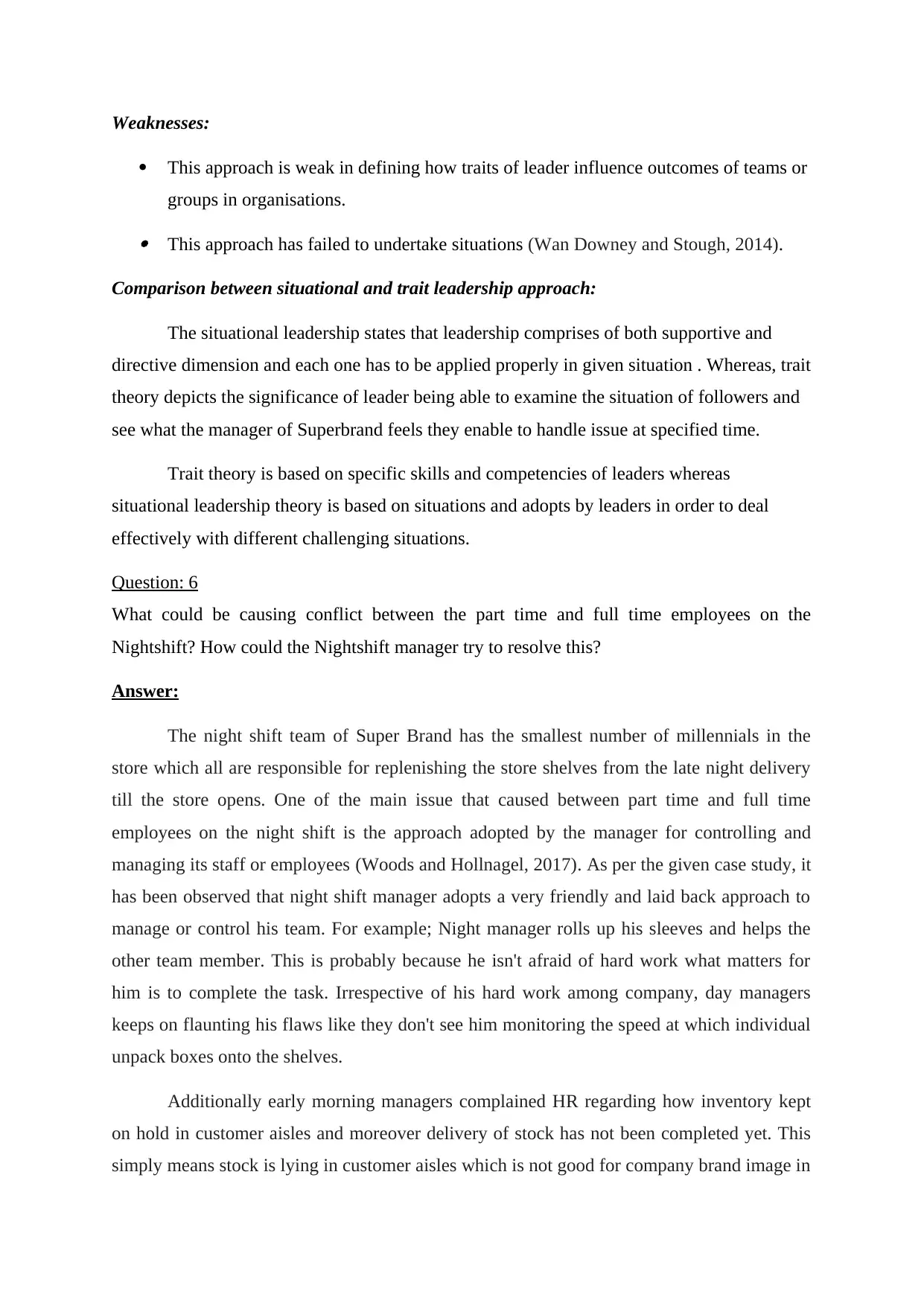
Weaknesses:
This approach is weak in defining how traits of leader influence outcomes of teams or
groups in organisations. This approach has failed to undertake situations (Wan Downey and Stough, 2014).
Comparison between situational and trait leadership approach:
The situational leadership states that leadership comprises of both supportive and
directive dimension and each one has to be applied properly in given situation . Whereas, trait
theory depicts the significance of leader being able to examine the situation of followers and
see what the manager of Superbrand feels they enable to handle issue at specified time.
Trait theory is based on specific skills and competencies of leaders whereas
situational leadership theory is based on situations and adopts by leaders in order to deal
effectively with different challenging situations.
Question: 6
What could be causing conflict between the part time and full time employees on the
Nightshift? How could the Nightshift manager try to resolve this?
Answer:
The night shift team of Super Brand has the smallest number of millennials in the
store which all are responsible for replenishing the store shelves from the late night delivery
till the store opens. One of the main issue that caused between part time and full time
employees on the night shift is the approach adopted by the manager for controlling and
managing its staff or employees (Woods and Hollnagel, 2017). As per the given case study, it
has been observed that night shift manager adopts a very friendly and laid back approach to
manage or control his team. For example; Night manager rolls up his sleeves and helps the
other team member. This is probably because he isn't afraid of hard work what matters for
him is to complete the task. Irrespective of his hard work among company, day managers
keeps on flaunting his flaws like they don't see him monitoring the speed at which individual
unpack boxes onto the shelves.
Additionally early morning managers complained HR regarding how inventory kept
on hold in customer aisles and moreover delivery of stock has not been completed yet. This
simply means stock is lying in customer aisles which is not good for company brand image in
This approach is weak in defining how traits of leader influence outcomes of teams or
groups in organisations. This approach has failed to undertake situations (Wan Downey and Stough, 2014).
Comparison between situational and trait leadership approach:
The situational leadership states that leadership comprises of both supportive and
directive dimension and each one has to be applied properly in given situation . Whereas, trait
theory depicts the significance of leader being able to examine the situation of followers and
see what the manager of Superbrand feels they enable to handle issue at specified time.
Trait theory is based on specific skills and competencies of leaders whereas
situational leadership theory is based on situations and adopts by leaders in order to deal
effectively with different challenging situations.
Question: 6
What could be causing conflict between the part time and full time employees on the
Nightshift? How could the Nightshift manager try to resolve this?
Answer:
The night shift team of Super Brand has the smallest number of millennials in the
store which all are responsible for replenishing the store shelves from the late night delivery
till the store opens. One of the main issue that caused between part time and full time
employees on the night shift is the approach adopted by the manager for controlling and
managing its staff or employees (Woods and Hollnagel, 2017). As per the given case study, it
has been observed that night shift manager adopts a very friendly and laid back approach to
manage or control his team. For example; Night manager rolls up his sleeves and helps the
other team member. This is probably because he isn't afraid of hard work what matters for
him is to complete the task. Irrespective of his hard work among company, day managers
keeps on flaunting his flaws like they don't see him monitoring the speed at which individual
unpack boxes onto the shelves.
Additionally early morning managers complained HR regarding how inventory kept
on hold in customer aisles and moreover delivery of stock has not been completed yet. This
simply means stock is lying in customer aisles which is not good for company brand image in
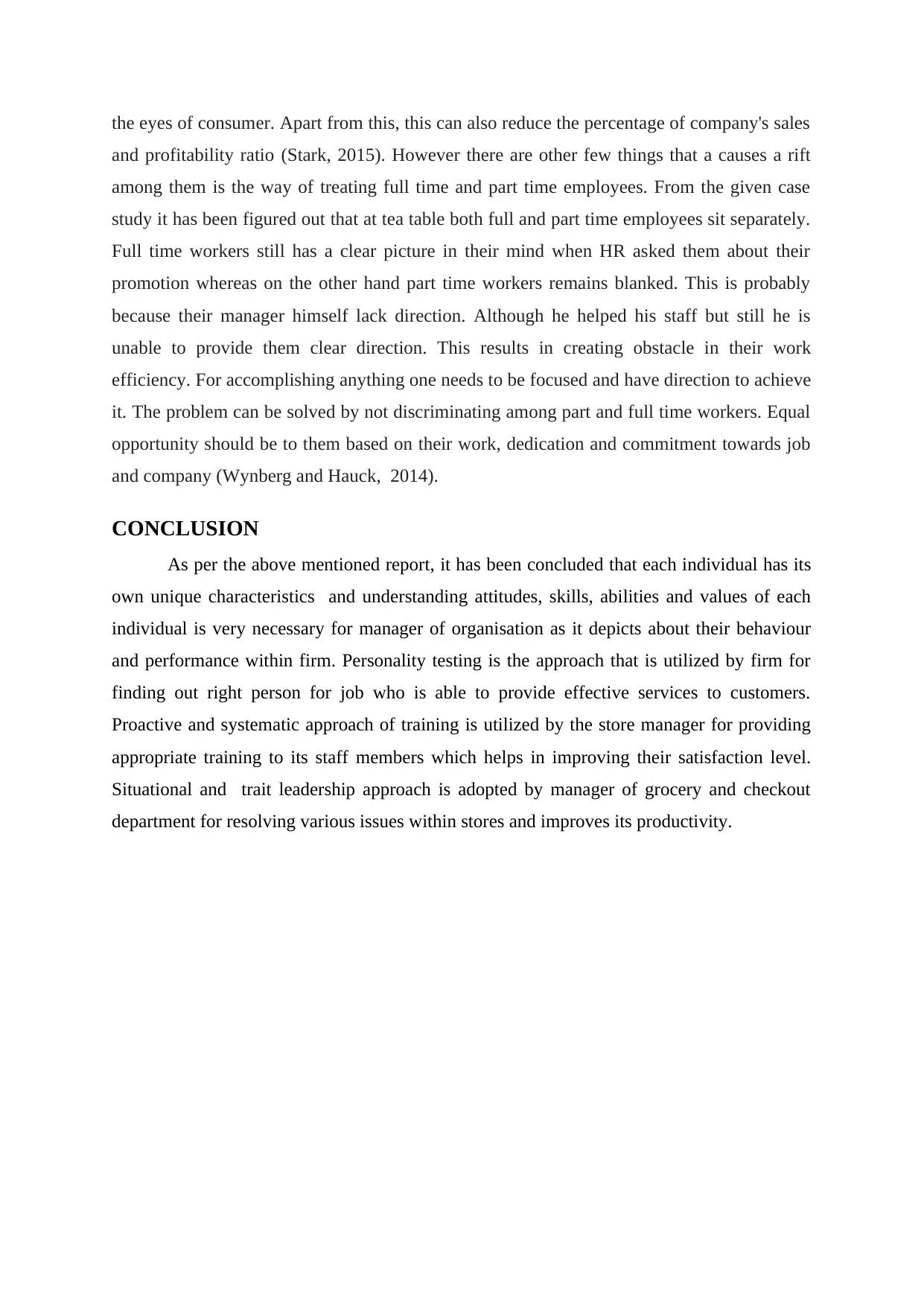
the eyes of consumer. Apart from this, this can also reduce the percentage of company's sales
and profitability ratio (Stark, 2015). However there are other few things that a causes a rift
among them is the way of treating full time and part time employees. From the given case
study it has been figured out that at tea table both full and part time employees sit separately.
Full time workers still has a clear picture in their mind when HR asked them about their
promotion whereas on the other hand part time workers remains blanked. This is probably
because their manager himself lack direction. Although he helped his staff but still he is
unable to provide them clear direction. This results in creating obstacle in their work
efficiency. For accomplishing anything one needs to be focused and have direction to achieve
it. The problem can be solved by not discriminating among part and full time workers. Equal
opportunity should be to them based on their work, dedication and commitment towards job
and company (Wynberg and Hauck, 2014).
CONCLUSION
As per the above mentioned report, it has been concluded that each individual has its
own unique characteristics and understanding attitudes, skills, abilities and values of each
individual is very necessary for manager of organisation as it depicts about their behaviour
and performance within firm. Personality testing is the approach that is utilized by firm for
finding out right person for job who is able to provide effective services to customers.
Proactive and systematic approach of training is utilized by the store manager for providing
appropriate training to its staff members which helps in improving their satisfaction level.
Situational and trait leadership approach is adopted by manager of grocery and checkout
department for resolving various issues within stores and improves its productivity.
and profitability ratio (Stark, 2015). However there are other few things that a causes a rift
among them is the way of treating full time and part time employees. From the given case
study it has been figured out that at tea table both full and part time employees sit separately.
Full time workers still has a clear picture in their mind when HR asked them about their
promotion whereas on the other hand part time workers remains blanked. This is probably
because their manager himself lack direction. Although he helped his staff but still he is
unable to provide them clear direction. This results in creating obstacle in their work
efficiency. For accomplishing anything one needs to be focused and have direction to achieve
it. The problem can be solved by not discriminating among part and full time workers. Equal
opportunity should be to them based on their work, dedication and commitment towards job
and company (Wynberg and Hauck, 2014).
CONCLUSION
As per the above mentioned report, it has been concluded that each individual has its
own unique characteristics and understanding attitudes, skills, abilities and values of each
individual is very necessary for manager of organisation as it depicts about their behaviour
and performance within firm. Personality testing is the approach that is utilized by firm for
finding out right person for job who is able to provide effective services to customers.
Proactive and systematic approach of training is utilized by the store manager for providing
appropriate training to its staff members which helps in improving their satisfaction level.
Situational and trait leadership approach is adopted by manager of grocery and checkout
department for resolving various issues within stores and improves its productivity.
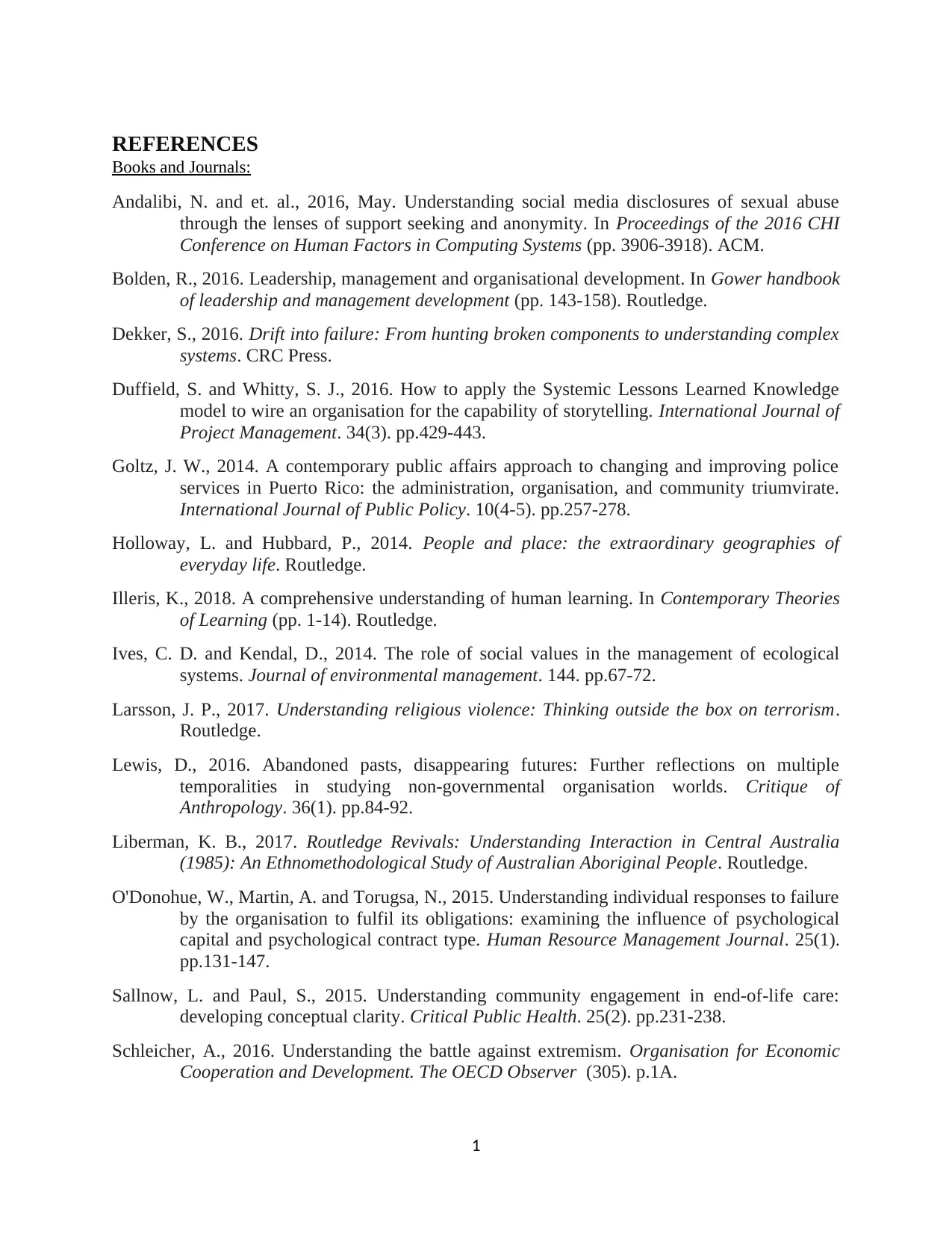
REFERENCES
Books and Journals:
Andalibi, N. and et. al., 2016, May. Understanding social media disclosures of sexual abuse
through the lenses of support seeking and anonymity. In Proceedings of the 2016 CHI
Conference on Human Factors in Computing Systems (pp. 3906-3918). ACM.
Bolden, R., 2016. Leadership, management and organisational development. In Gower handbook
of leadership and management development (pp. 143-158). Routledge.
Dekker, S., 2016. Drift into failure: From hunting broken components to understanding complex
systems. CRC Press.
Duffield, S. and Whitty, S. J., 2016. How to apply the Systemic Lessons Learned Knowledge
model to wire an organisation for the capability of storytelling. International Journal of
Project Management. 34(3). pp.429-443.
Goltz, J. W., 2014. A contemporary public affairs approach to changing and improving police
services in Puerto Rico: the administration, organisation, and community triumvirate.
International Journal of Public Policy. 10(4-5). pp.257-278.
Holloway, L. and Hubbard, P., 2014. People and place: the extraordinary geographies of
everyday life. Routledge.
Illeris, K., 2018. A comprehensive understanding of human learning. In Contemporary Theories
of Learning (pp. 1-14). Routledge.
Ives, C. D. and Kendal, D., 2014. The role of social values in the management of ecological
systems. Journal of environmental management. 144. pp.67-72.
Larsson, J. P., 2017. Understanding religious violence: Thinking outside the box on terrorism.
Routledge.
Lewis, D., 2016. Abandoned pasts, disappearing futures: Further reflections on multiple
temporalities in studying non-governmental organisation worlds. Critique of
Anthropology. 36(1). pp.84-92.
Liberman, K. B., 2017. Routledge Revivals: Understanding Interaction in Central Australia
(1985): An Ethnomethodological Study of Australian Aboriginal People. Routledge.
O'Donohue, W., Martin, A. and Torugsa, N., 2015. Understanding individual responses to failure
by the organisation to fulfil its obligations: examining the influence of psychological
capital and psychological contract type. Human Resource Management Journal. 25(1).
pp.131-147.
Sallnow, L. and Paul, S., 2015. Understanding community engagement in end-of-life care:
developing conceptual clarity. Critical Public Health. 25(2). pp.231-238.
Schleicher, A., 2016. Understanding the battle against extremism. Organisation for Economic
Cooperation and Development. The OECD Observer (305). p.1A.
1
Books and Journals:
Andalibi, N. and et. al., 2016, May. Understanding social media disclosures of sexual abuse
through the lenses of support seeking and anonymity. In Proceedings of the 2016 CHI
Conference on Human Factors in Computing Systems (pp. 3906-3918). ACM.
Bolden, R., 2016. Leadership, management and organisational development. In Gower handbook
of leadership and management development (pp. 143-158). Routledge.
Dekker, S., 2016. Drift into failure: From hunting broken components to understanding complex
systems. CRC Press.
Duffield, S. and Whitty, S. J., 2016. How to apply the Systemic Lessons Learned Knowledge
model to wire an organisation for the capability of storytelling. International Journal of
Project Management. 34(3). pp.429-443.
Goltz, J. W., 2014. A contemporary public affairs approach to changing and improving police
services in Puerto Rico: the administration, organisation, and community triumvirate.
International Journal of Public Policy. 10(4-5). pp.257-278.
Holloway, L. and Hubbard, P., 2014. People and place: the extraordinary geographies of
everyday life. Routledge.
Illeris, K., 2018. A comprehensive understanding of human learning. In Contemporary Theories
of Learning (pp. 1-14). Routledge.
Ives, C. D. and Kendal, D., 2014. The role of social values in the management of ecological
systems. Journal of environmental management. 144. pp.67-72.
Larsson, J. P., 2017. Understanding religious violence: Thinking outside the box on terrorism.
Routledge.
Lewis, D., 2016. Abandoned pasts, disappearing futures: Further reflections on multiple
temporalities in studying non-governmental organisation worlds. Critique of
Anthropology. 36(1). pp.84-92.
Liberman, K. B., 2017. Routledge Revivals: Understanding Interaction in Central Australia
(1985): An Ethnomethodological Study of Australian Aboriginal People. Routledge.
O'Donohue, W., Martin, A. and Torugsa, N., 2015. Understanding individual responses to failure
by the organisation to fulfil its obligations: examining the influence of psychological
capital and psychological contract type. Human Resource Management Journal. 25(1).
pp.131-147.
Sallnow, L. and Paul, S., 2015. Understanding community engagement in end-of-life care:
developing conceptual clarity. Critical Public Health. 25(2). pp.231-238.
Schleicher, A., 2016. Understanding the battle against extremism. Organisation for Economic
Cooperation and Development. The OECD Observer (305). p.1A.
1
Paraphrase This Document
Need a fresh take? Get an instant paraphrase of this document with our AI Paraphraser
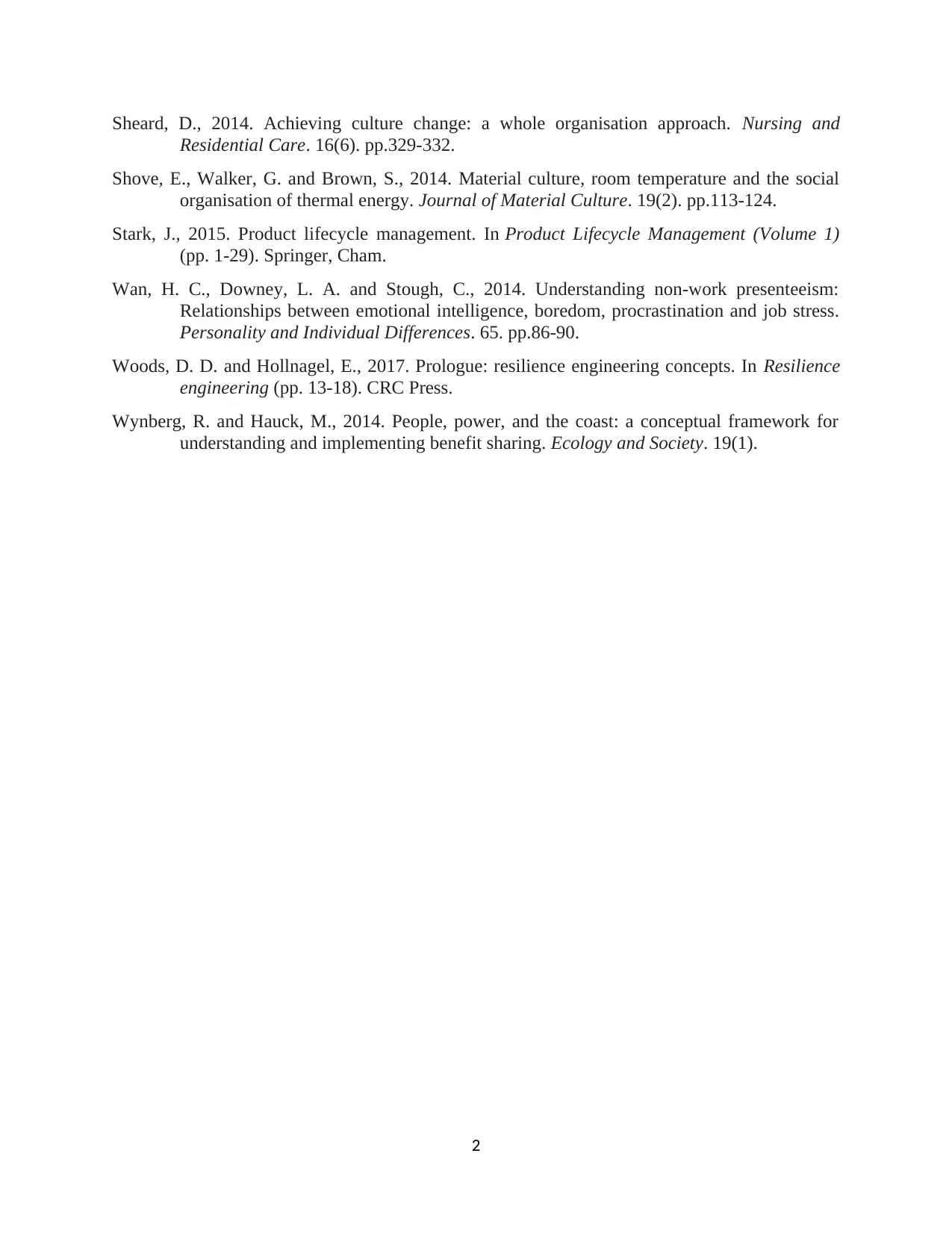
Sheard, D., 2014. Achieving culture change: a whole organisation approach. Nursing and
Residential Care. 16(6). pp.329-332.
Shove, E., Walker, G. and Brown, S., 2014. Material culture, room temperature and the social
organisation of thermal energy. Journal of Material Culture. 19(2). pp.113-124.
Stark, J., 2015. Product lifecycle management. In Product Lifecycle Management (Volume 1)
(pp. 1-29). Springer, Cham.
Wan, H. C., Downey, L. A. and Stough, C., 2014. Understanding non-work presenteeism:
Relationships between emotional intelligence, boredom, procrastination and job stress.
Personality and Individual Differences. 65. pp.86-90.
Woods, D. D. and Hollnagel, E., 2017. Prologue: resilience engineering concepts. In Resilience
engineering (pp. 13-18). CRC Press.
Wynberg, R. and Hauck, M., 2014. People, power, and the coast: a conceptual framework for
understanding and implementing benefit sharing. Ecology and Society. 19(1).
2
Residential Care. 16(6). pp.329-332.
Shove, E., Walker, G. and Brown, S., 2014. Material culture, room temperature and the social
organisation of thermal energy. Journal of Material Culture. 19(2). pp.113-124.
Stark, J., 2015. Product lifecycle management. In Product Lifecycle Management (Volume 1)
(pp. 1-29). Springer, Cham.
Wan, H. C., Downey, L. A. and Stough, C., 2014. Understanding non-work presenteeism:
Relationships between emotional intelligence, boredom, procrastination and job stress.
Personality and Individual Differences. 65. pp.86-90.
Woods, D. D. and Hollnagel, E., 2017. Prologue: resilience engineering concepts. In Resilience
engineering (pp. 13-18). CRC Press.
Wynberg, R. and Hauck, M., 2014. People, power, and the coast: a conceptual framework for
understanding and implementing benefit sharing. Ecology and Society. 19(1).
2
1 out of 14
Related Documents
Your All-in-One AI-Powered Toolkit for Academic Success.
+13062052269
info@desklib.com
Available 24*7 on WhatsApp / Email
![[object Object]](/_next/static/media/star-bottom.7253800d.svg)
Unlock your academic potential
© 2024 | Zucol Services PVT LTD | All rights reserved.





